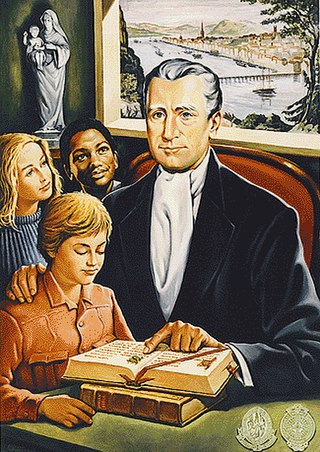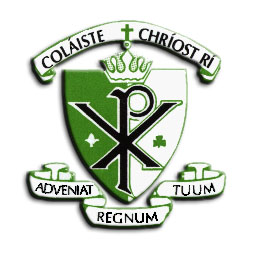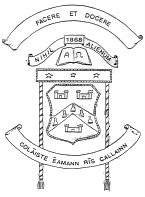
Edmund Ignatius Rice, F.P.M., C.F.C. was a Catholic missionary and educationalist who founded two institutes of religious brothers: the Congregation of Christian Brothers and the Presentation Brothers.

The Congregation of Christian Brothers is a worldwide religious community within the Catholic Church, founded by Edmund Rice.

Venerable Honora Nagle, known informally as Nano Nagle, was a pioneer of Catholic education in Ireland despite legal prohibitions. She founded the Sisters of the Presentation of the Blessed Virgin Mary (PBVM), commonly known as the Presentation Sisters, now a worldwide Catholic institute of women religious. She was declared venerable in the Roman Catholic Church on 31 October 2013 by Pope Francis.
Edmund Rice Camps is a charitable volunteer organisation closely associated with the Congregation of Christian Brothers, and inspired by the work of Edmund Ignatius Rice.
Presentation College, Chaguanas is a Roman Catholic secondary school in Chaguanas, Trinidad and Tobago and is the brother school of Presentation College, San Fernando.

Brebeuf College School is a publicly funded Roman Catholic all-boys high school in Toronto, Ontario, Canada endorsed by the Jesuits of Canada. Founded by the Jesuits in 1963, it is part of the Toronto Catholic District School Board and associated with the Presentation Brothers since 1984. Brebeuf is the brother school of nearby St. Joseph's Morrow Park Catholic Secondary School.

The Dominican Order has been present in Ireland since 1224 when the first foundation was established in Dublin, a monastic settlement north of the River Liffey, where the Four Courts is located today. This was quickly followed by Drogheda, Kilkenny (1225), Waterford (1226), Limerick (1227) and Cork (city) (1229). The order was reestablished in the 19th century after having been driven out in the 17th century by laws against Catholic religious orders. During the Penal Laws, as other Irish Colleges were established on the continent, in 1633 the Irish Dominicans established, the College of Corpo Santo, Lisbon and College of the Holy Cross, Louvain (1624-1797) to train clergy for ministering in Ireland. San Clemente al Laterano in Rome, was entrusted to the Irish Dominicans in 1677. In 1855, St. Mary's Priory, Tallaght, was established to train members of the order, who would complete their clerical studies in Rome and be ordained in the Basilica San Clemente.

Coláiste Chríost Rí is a Catholic secondary school for boys based on Capwell Road in Turners Cross, Cork, Ireland. The school, which is under the trusteeship of the Presentation Brothers Schools Trust, had an enrollment of 513 students as of 2023.
Ballyphehane is a suburb in the south of Cork in Ireland. It is one of the oldest suburbs in Cork and was created as part of a post-World War II initiative to create a model community in Cork. Between 1948 and 1993, a total of 11 housing schemes totalling 1,316 dwellings were built by Cork Corporation, now known as Cork City Council. Many of the main roads in Ballyphehane are named after the executed leaders of the 1916 Rising.
The Congregation of Christian Brothers in New Zealand is part of the Congregation of Christian Brothers, a Catholic religious institute, and has been established in New Zealand since 1876. Its particular charism is the education of boys and in New Zealand it has been responsible for eight schools and has launched other educational initiatives.
Presentation College or Presentation Brothers College can refer to:
Events from the year 1808 in Ireland.

Coláiste Éamann Rís(Edmund Rice College) was a Christian Brothers secondary school for boys located in Callan, County Kilkenny, in Ireland.
The Le Chéile Schools Trust is a charitable trust which manages around 60 schools in Ireland on behalf of fifteen Roman Catholic religious congregations.
Catholic Education, an Irish Schools Trust (CEIST) is the trustee body for 107 Catholic Voluntary Secondary Schools in Ireland. CEIST provides the moral and legal framework that enable its schools to offer second level Catholic education in Ireland. Its role is built on the vision of its five founding congregations Daughters of Charity, Presentation Sisters, Sisters of the Christian Retreat, Sisters of Mercy and Missionaries of the Sacred Heart. These religious congregations established CEIST in 2007 to ensure the viability of Catholic Education at post-primary level in Ireland into the future.
The 1980–81 Harty Cup was the 61st staging of the Harty Cup since its establishment in hurling by the Munster Council of Gaelic Athletic Association in 1918. The competition contested from 8 October 1980 to 5 April 1981.






